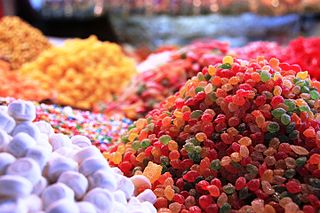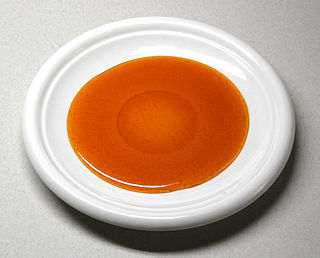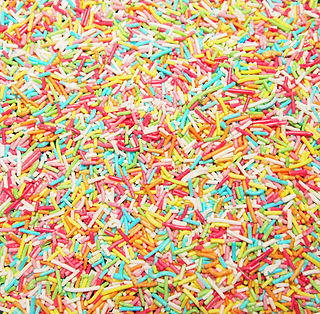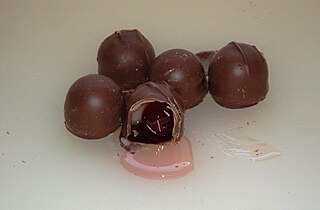
Dessert is a course that concludes a meal. The course consists of sweet foods, such as candy, and possibly a beverage such as dessert wine and liqueur. In some parts of the world, such as Greece and West Africa, and most parts of China, there is no tradition of a dessert course to conclude a meal.

Confectionery is the art of making confections, which are food items that are rich in sugar and carbohydrates. Exact definitions are difficult. In general, however, confectionery is divided into two broad and somewhat overlapping categories: bakers' confections and sugar confections. The occupation of confectioner encompasses the categories of cooking performed by both the French patissier and the confiseur.

Candy, also called sweets or lollies, is a confection that features sugar as a principal ingredient. The category, called sugar confectionery, encompasses any sweet confection, including chocolate, chewing gum, and sugar candy. Vegetables, fruit, or nuts which have been glazed and coated with sugar are said to be candied.

Caramel is an orange-brown confectionery product made by heating a range of sugars. It can be used as a flavoring in puddings and desserts, as a filling in bonbons, or as a topping for ice cream and custard.

Pralines are confections containing nuts – usually almonds, pecans and hazelnuts – and sugar. Cream is a common third ingredient.

A chocolate brownie, or simply a brownie, is a chocolate baked confection. Brownies come in a variety of forms and may be either fudgy or cakey, depending on their density. Brownies often, but not always, have a glossy "skin" on their upper crust. They may also include nuts, frosting, cream cheese, chocolate chips, or other ingredients. A variation made with brown sugar and vanilla rather than chocolate in the batter is called a blond brownie or blondie. The brownie was developed in the United States at the end of the 19th century and popularized there during the first half of the 20th century.

Fudge is a type of confection that is made by mixing sugar, butter and milk. It has its origins in 19th century USA and was popular in the women's colleges of the time. Fudge can come in a variety of flavorings depending on the region or country it was made; popular flavors include fruit, nut, chocolate and caramel. Fudge is often bought as a gift from a gift shop in tourist areas and attractions.

Sprinkles are small pieces of confectionery used as an often colourful decoration or to add texture to desserts such as brownies, cupcakes, doughnuts or ice cream. The tiny candies are produced in a variety of colors and are generally used as a topping or a decorative element. The Dictionary of American Regional English defines them as "tiny balls or rod-shaped bits of candy used as a topping for ice-cream, cakes and other."

The brigadeiro is a traditional Brazilian dessert. The origin of the dessert is uncertain, but the most common theory is that it was created by a confectioner from Rio de Janeiro, Heloisa Nabuco de Oliveira, to promote the presidential candidacy of Eduardo Gomes. It is made of condensed milk, cocoa powder, butter, and chocolate sprinkles covering the outside layer.

The Nanaimo bar is a bar dessert that requires no baking and is named after the Canadian city of Nanaimo in British Columbia. It consists of three layers: a wafer, nut, and coconut crumb base; custard icing in the middle; and a layer of chocolate ganache on top. Many varieties exist, consisting of various types of crumb, various flavours of icing, and various types of chocolate.

Black Forest gâteau, also called Black Forest cake is a chocolate and cream cake with a rich cherry filling based on a German dessert.

Nonpareils are a decorative confectionery of tiny balls made with sugar and starch, traditionally an opaque white but now available in many colors. They are also known as hundreds and thousands in Australia, New Zealand, South Africa and the United Kingdom.

Cella's is a brand of cherry cordial confection marketed by Chicago-based Tootsie Roll Industries, who purchased the brand in 1985. They were originally introduced in 1864.

A cordial is a type of confection in which liquid filling is placed within a chocolate shell. A well known confectionery of this type is the cherry cordial.
The following outline is provided as an overview of and topical guide to chocolate:

Chocolate-covered fruits include blueberries, pomegranate, strawberries, oranges, dried apricots, and other candied fruits and citrus peels. Dark chocolate, milk chocolate and white chocolate are used for decoration. Nuts, coconut, chocolate chips, sprinkles, and other toppings are sometimes added. During the Christmas season chocolate covered fruits are sold at European markets.

















